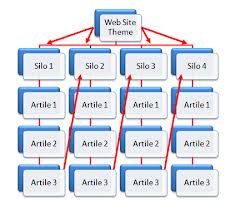What is a Silo Structure Website?
Silo is a term used in SEO when comes to setting up your website in a search engine friendly yet categorized fashion. A website with proper Silo theme structure setup can easily rank well in search engine as compare to those who don’t.
Silo is a preferred way for experienced marketer when comes to building their website. Search engine especially Google tends to reward high quality content rich site with much higher ranking if the site is structured properly with a silo fashion.
Why is It Important to Silo Your Website?

Silo Structure
Search Engine works like an organization. Search engine spider prefers to crawl your web pages in a hierarchical fashion rather than flipping ups and downs figuring up what your site is all about.
Siloing is an SEO architecture term that optimizes the overall site’s structure, organizing your article content into mini-silos based on your defined search pattern which related to your target keywords. In order to increase relevancy in the eyes of the search engines, Silo is often used by experienced marketer as a secret weapon to outrank their competitors in organic SEO war.
Remember my earlier discussion on: “is SEO death?” I escalated that a good backlinking strategy needs to have a balance of inbound link(internal link) and outbound link(external link) to look naturally in the eyes of search engine. A Silo site actually meets this criteria flawlessly.
3 Steps to Siloing:
A proper silo MUST include the followings:
- A main topic in related to your subject manner based on your keyword research.
- Secondary main keywords to be utilized for your silo category pages.
- Categorize the structure properly via child pages with more sub keywords.
Silo structure is very important to your overall site architecture. The information gives search engine spider a very clear idea of what your site is all about, improving your keyword relevancy for the keywords you are targeting, in returns rewards your site for long term success.
I am going to use “Gout” as a subject topic for basic illustration. If Gout is your main subject, then your silo pages should consist of relevant information such as Gout treatment, Gout symptoms, Gout Diet and etc. And it depends on how deep you go down to the sub-silo architecture. For example, Gout treatment can further drill down to Gout natural treatment, home treatment, OTC treatment, herbal remedies etc.
The concept of Silo has been around for a long time, but I seldom heard people talk about it, not even the SEO Guru. Siloing is a white hat SEO technique. Indeed, it’s also my preferred way of constructing many of my websites nowadays.
Tell you a secret, Google is in favor of silo site not against it:) Why do you think web sites such as Wikipedia and Amazon can rank high in the search engine for almost every keyword you search online? The answer is SILO:)
Proper Silo Structure Format
When comes to categorizing your silo sites. The foundation start from page, not post. The index page such as “Gout” is the generic main term. It then links to category pages such as “Gout treatment” (NOT WORDPRESS CATEGORIES) which in turn link to category child pages such as “OTC Treatment” and etc. The child pages link to each other but no where else. You would then repeat this process for any other silo categories. As for posts, you will want to have regular fresh content and link back to the relevant pages occasionally. Only interlink the post if you find the subject is relevant to one and another.
Wrapping Up
If you haven’t really thought of Siloing your site layout, I would strongly suggest you to start building your next website based on a proper silo fashion. Trust me, this will reward you in the long run and will bring more benefits than harm to your overall site structure. Apart from SEO benefits, silo also helps with user navigation. When you engage the user, you win:)
I hope this article give you a good introduction of what is a SILO structure. Feel free to tweet about it, share it on Facebook if you find it helpful.





Leave a Reply
You must be logged in to post a comment.